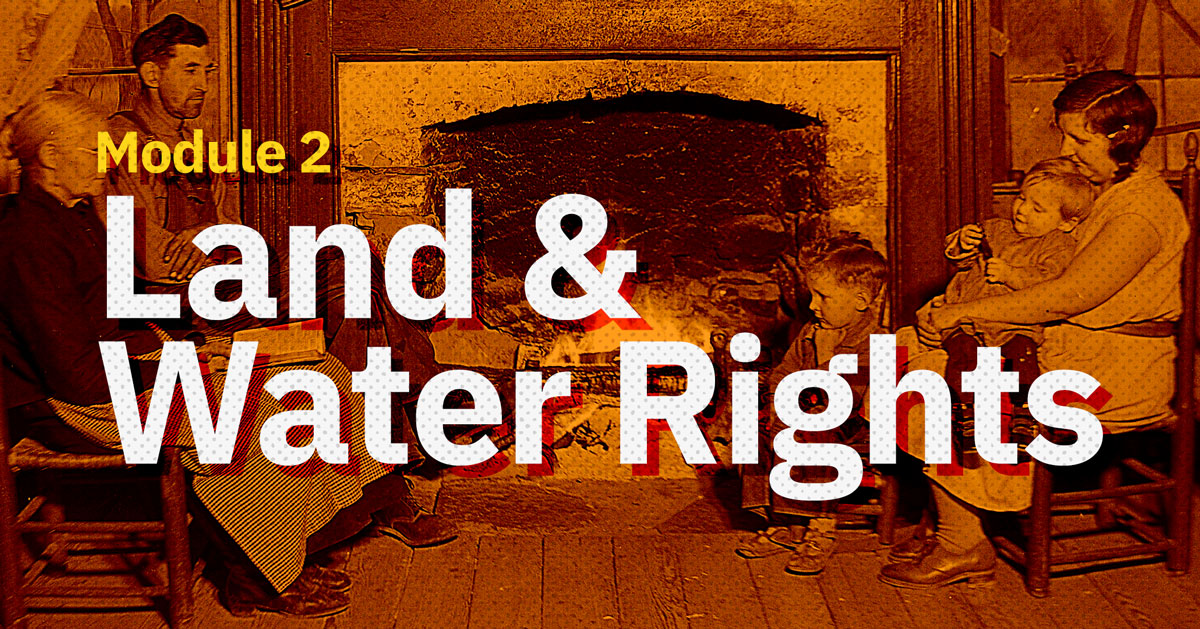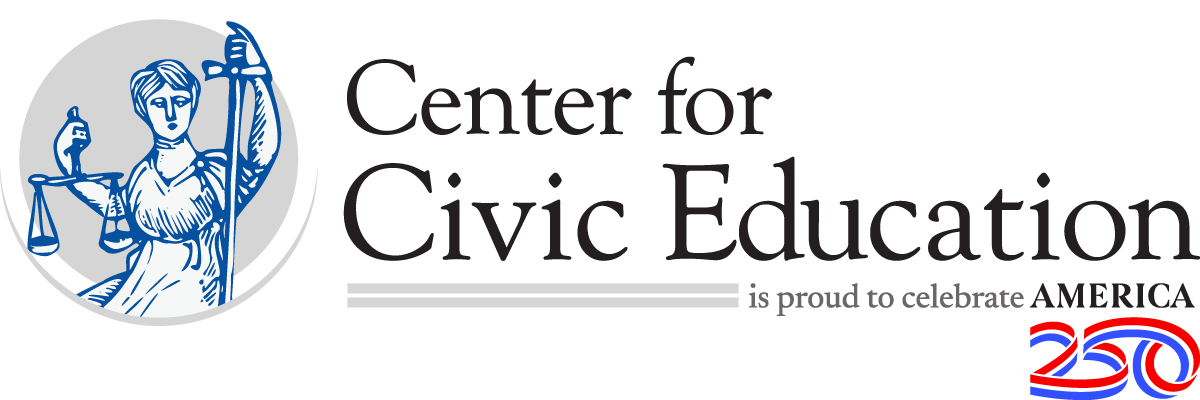
Module 2: Land & Water Rights
In this lesson, students will explore the U.S. government’s use of annexation and eminent domain in both rural and Indigenous communities. Students will examine if rights have been protected or denied to these groups. The history of Indigenous peoples in this country has been marked by profound tragedy since explorers and colonizers first arrived in North America, while rural communities in the United States have long been marginalized and underserved.
Lesson Plan: Day 1
- Welcome students to social studies.
- Using your routine strategy for setting up groups, divide the class into small teams of three to four members.
- Distribute the Observe & Wonder image sets and assign each team to one of the three image sets.
- Distribute the Observe & Wonder Organizer, and instruct students to work collaboratively to take a close look at their assigned images in order to complete the organizer.
- Utilize the slide 5 of the Land & Water Rights Indigenous Communities slide deck to review expectations.
- Encourage teams to be creative in their observations.
- Circulate around the room, encouraging each team, observing progress, and redirecting as needed.
- Return to a full-class format and allow students to briefly share their observations, which should include the following:
- Image Set 1: sugarcane being harvested; processed sugar
- Image Set 2: coffee cherries being harvested; roasted coffee beans
- Image Set 3: pineapples being harvested; pineapple
- Utilize slide 6 of the Land & Water Rights Indigenous Communities slide deck to facilitate a class discuss by asking the following questions:
- What do these images have in common?
- How/where do we see these items in our own lives?
- Where do these items grow?
- Do you think these items are grown in the United States? Why or why not?
- Educators can support concept attainment by having examples of these items, such as a carryout coffee cup, packets of sugar, and a pineapple fruit-cup snack.
- Tell students that items cannot grow natively on the mainland of the United States; however, all three items are grown on the islands of Hawaiʻi.
- Ask students to make predictions as to why sugar, coffee, and pineapples are grown in Hawaiʻi and record student responses on an anchor chart.
- Teachers can offer geographical trivia by sharing the distance from Southern California to Hawaiʻi is 2,473 miles. For perspective, the distance from Washington, D.C., to Los Angeles is 2,670 miles.
- Utilize slide 7 of the Land & Water Rights Indigenous Communities slide deck to facilitate a brief class discussion by asking the following questions:
- Was Hawaiʻi always a U.S. state?
- Hawaiʻi did not become a U.S. state until 1959.
- How was Hawaiʻi governed before it was a U.S. state?
- Hawaiʻi was ruled by a monarchy (king and queen) and was an independent nation.
- Why did some Americans suggest that Hawaiʻi should become a part of the United States?
- Reasons may include agricultural opportunities (sugarcane, coffee, pineapples), strategic military site, the United States was seeking ways to expand its territory
- Was Hawaiʻi always a U.S. state?
- Tell students that today we will begin to explore how Hawaiʻi became a state.
- Utilize slide 8 of the Land & Water Rights Indigenous Communities slide deck to introduce the inquiry question: “Who has the right to own land and water?”
- Allow students time to make a prediction about the compelling question as well as offer their own supporting questions.
Universal Design for Learning (UDL)
- Students are introduced to the topic through visual discovery to support concept attainment.
- Allow sufficient wait time for students to formulate an opinion and offer feedback.
- Consider allowing students trio time to formulate answers.
Multilingual Learners (ML)
Social-Emotional Learning (SEL)
Civic Skills & Dispositions
Extending Learning
- Using the vocabulary slide deck for Day 1 (slide 16), match challenging academic terms with simpler synonyms or phrases using a “word-phrase swap” activity.
- Utilize slide 9 of the Land & Water Rights Indigenous Communities slide deck to introduce the definition of annexation: possession taken of a piece of land or a country, usually by force or without permission.
- Tell students that annexation is a one-sided act where one territory is seized and held by another. A territory can be annexed through military conquest and occupation; a treaty of cession, where one country formally transfers territory to another; a voluntary petition by residents of the territory to be annexed; or through a referendum where the residents of the territory vote to join another state.
- Express that annexation is a controversial topic. Some examples of annexation led by the U.S. government include the following:
- The 1819 purchase of East and West Florida from Spain
- The 1848 Treaty of Guadalupe Hidalgo, where the United States purchased Arizona, California, New Mexico, and Texas, as well of parts of Colorado, Nevada, and Utah from Mexico
- The 1898 Spanish cession of Puerto Rico to the United States after the Spanish-American War
- The 1898 overthrow of the Hawaiʻian monarchy by the United States
- Provide space for students to share thoughts and observations that surface after considering the process of annexation.
- Utilize slide 10 of the Land & Water Rights Indigenous Communities slide deck to display and read aloud the Land Acknowledgment for Hawaiʻi.
- Provide space for students to share thoughts and observations that surface after hearing the land-acknowledgement statement.
- Tell students that they will set out on a voyage to discover the history of Hawaiʻi to determine if the United States government had the right to take the land from Hawaiʻi.
- Set up five stations around the classroom, placing one stop from the Annexation of Hawaiʻi Stops at each station. Utilize slide 10 of the Land & Water Rights: Indigenous Communities slide deck to explain the procedure. Simple stations can be set up at five spots in the classroom featuring digital or paper-copy resources for students to investigate.
- Distribute copies of the Passport booklet and review to ensure students comprehend expectations.
- Note: Teacher should assemble the Passport booklet prior to presenting the activity for best implementation.
- Students will visit each stop to investigate the primary source. In their Passport, students will provide a brief summary of each primary source, determine if the source is for or against annexation, and provide evidence to support their claim.
- Using your routine strategy for setting up groups, divide the class into small teams of four to five members and assign each team to one of the respective stations.
- Allow students to work collaboratively to observe and analyze each station.
- Rotate teams to ensure they visit each station.
- Circulate around the room, encouraging each team, observing progress, and redirecting as needed.
Universal Design for Learning (UDL)
- Utilize the Land & Water Rights: Indigenous Communities slide deck for vocabulary support starting on slide 15.
- Educator might model how to use the Passport booklet by completing Stop #1 in the Annexation of Hawaiʻi Stops together.
- Alternatively, each group could be assigned only one of the Annexation of Hawaiʻi Stops and share out in a modified jigsaw format. However, a fuller understanding of the annexation events and a richer class conversation will result in students exploring all five stops.
Multilingual Learners (ML)
Social-Emotional Learning (SEL)
Civic Skills & Dispositions
Extending Learning
- Return to a full-class format and briefly review each stop in the Passport, which may include the following:
- Stop 1: History—could be against or neutral about annexation; lift up the fact that Native Hawaiʻians were self-sufficient prior to contact with Europeans.
- Stop 2: Queen’s letter—against annexation; queen tells Congress that she and Hawaiʻi are not willing to become part of the United States.
- Stop 3: Committee of Safety—for annexation; describes how the interest of sugarcane businessmen influence the U.S. government’s actions.
- Stop 4: Petition—against annexation; illustrates that over half of the islands’ population were opposed to losing their country to America.
- Stop 5: Song and ad—for annexation; both items showcase Americans who supported the overthrow of the queen and takeover of the nation.
- Teachers may wish to utilize slide 12 of the Land & Water Rights Indigenous Communities slide deck to drop and drag each station in the For or Against Annexation table.
- Encourage students to complete page 6 of their Passport as each stop is reviewed.
- Facilitate an optional class discussion by asking if the following groups or individuals acted best interests of the Native Hawaiʻians:
- Businessmen on the Committee of Safety
- Queen Lili’uokalani
- U.S. Congress
- U.S. President
- American public
- Native Hawaiʻians themselves
- Encourage students to explain their reasoning.
- Thank students for participating in this civic conversation.
Universal Design for Learning (UDL)
- Allow sufficient wait time for students to formulate answers and offer feedback.
- Consider allowing students trio time to formulate answers.
Multilingual Learners (ML)
Social-Emotional Learning (SEL)
Civic Skills & Dispositions
Extending Learning
- Distribute the How Would You Decide Annexation? resource sheet and utilize slide 13 of the Land & Water Rights Indigenous Communities slide deck to ensure students comprehend expectations.
- Working in teams, students will read each scenario to determine if the individual would support or oppose the U.S. annexation of Hawaiʻi. Remind students to explain why they made that decision and provide evidence for their claim.
- If time allows, each team can work collaboratively to create their own scenario to share with another team to solve.
- Tell students that we will now hear about how land and water rights play out today in real life for one member of the Pyramid Lake Paiute Tribe in Nevada.
- Play the Scholar video and as students watch, they should listen for obstacles tribal members have faced with regard to land and water rights.
- Play the video a second time to ensure comprehension.
- Facilitate a brief class discussion encouraging students to share land and water rights obstacles they heard. Possible answers may include the following:
- Required membership of a specific tribe
- Levels of jurisdiction, including local, state, federal, and tribal governments
- Land-back efforts (returning of land to Indigenous peoples that was taken during colonization)
- Coming to a consensus on land use and/or conversation efforts
- Ask students how examples shared in our scholar video can connect to what we have learned about the annexation of Hawai’i.
Universal Design for Learning (UDL)
- Allow for students to record answers in written or audio format.
- Encourage group members to probe each others’ thinking with questions such as the following:
- Why do you think that?
- What makes you say that?
Multilingual Learners (ML)
Social-Emotional Learning (SEL)
Civic Skills & Dispositions
Extending Learning
- Distribute the Sensory Figure.
- Utilize slide 14 of the Land & Water Rights Indigenous Communities slide deck to explain that students will select one individual who was a resident of Hawaiʻi at the time of the annexation. Possible residents might include a Native Hawaiʻian, Queen Lili’uokalani, an owner of a sugarcane production operation, a newspaper reporter, a Christian missionary, a U.S. military service member, a small business owner, etc.
- Students will individually complete the sensory figure, imagining the reactions, observations ,and feelings of their selected Hawaiʻian resident at the time of the annexation.
- Encourage students to answer the supporting question: “Did the U.S. government have the right to take the land from Hawaiʻi?”
- Conduct a class poll allowing students to take a stand and vote on the supporting question: “Did the U.S. government have the right to take the land from Hawaiʻi?” The vote may be conducted by secret ballot or show of hands.
- Display results and thank students for participating in this democratic experience of voting.
- Probe students’ thinking to explain their reasoning behind their vote on the supporting question.
- If time allows, display completed sensory figures for a gallery walk, where students are encouraged to reflect on the observations offered by their classmates.
Universal Design for Learning (UDL)
- Allow for students to record answers in written or audio format.
- Support students’ understanding by modeling one of the senses on the Sensory Figure together as a class.
Multilingual Learners (ML)
Social-Emotional Learning (SEL)
Civic Skills & Dispositions
Extending Learning






